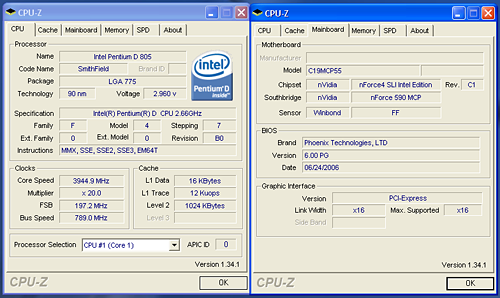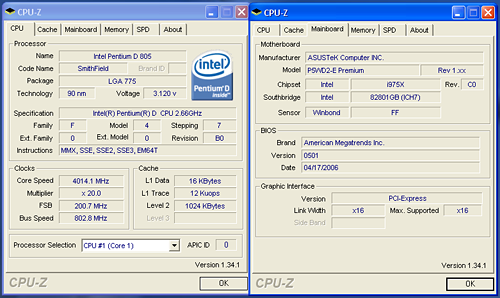nForce 590 SLI Intel Edition: NVIDIA prepares an Intel 975X Killer
by Gary Key on June 27, 2006 6:15 AM EST- Posted in
- CPUs
FSB Overclocking Results


Even though the board and the BIOS have not been optimized for overclocking yet, the results with our Pentium D 805 were impressive. The BIOS was hard locked at a 200FSB and we actually noticed this issue starting at the 197FSB setting. We have no doubt the board would have equaled the ASUS's 200FSB result with our retail chip had the BIOS been tuned for overclocking. The results on the Asus board were superb and with additional cooling and voltage settings we have booted this combination at 4.6GHz. Our retail chip was manufactured in February so it would not be too hard to imagine the current yields equaling or better this performance. At a soon to be $93 or lower retail cost, this has to be the bargain performance CPU of the year. If paired with the right video card, you can have a very enjoyable gaming experience for a small cash outlay.
Test Systems: Benchmark Setup
Both boards fully support all current socket 775 Intel processors. We are benchmarking with the Pentium D 805 processor but will follow up shortly with the Pentium 950D and 955XE once we receive our revised reference board and BIOS. The board fully supports Core 2 Duo processors although we cannot provide results at this time due to NDA restrictions.
A 2GB memory configuration is now standard in the AT test bed as most enthusiasts are currently purchasing this amount of memory. We chose memory from Corsair that would offer a wide range of memory settings during our stock and overclocked test runs. Our memory timings are set based upon determining the best memory bandwidth via MemTest86 and our test application results. All other components in our two test configurations are exactly the same with the boards being set up in their default configurations. Our video tests are run at 1280x1024 resolution at standard settings. We will not report on 1600x1200 4xAA/8xAF single and SLI results until we have a production ready board to review. This holds true for the balance of our Networking, Storage System, and Audio benchmarks.


Even though the board and the BIOS have not been optimized for overclocking yet, the results with our Pentium D 805 were impressive. The BIOS was hard locked at a 200FSB and we actually noticed this issue starting at the 197FSB setting. We have no doubt the board would have equaled the ASUS's 200FSB result with our retail chip had the BIOS been tuned for overclocking. The results on the Asus board were superb and with additional cooling and voltage settings we have booted this combination at 4.6GHz. Our retail chip was manufactured in February so it would not be too hard to imagine the current yields equaling or better this performance. At a soon to be $93 or lower retail cost, this has to be the bargain performance CPU of the year. If paired with the right video card, you can have a very enjoyable gaming experience for a small cash outlay.
Test Systems: Benchmark Setup
Both boards fully support all current socket 775 Intel processors. We are benchmarking with the Pentium D 805 processor but will follow up shortly with the Pentium 950D and 955XE once we receive our revised reference board and BIOS. The board fully supports Core 2 Duo processors although we cannot provide results at this time due to NDA restrictions.
| Test Systems | |
| Processor: | Intel Pentium D - 805 |
| RAM: | 2 x 1GB Corsair TWIN2X2048-6400C3 |
| RAM Settings: | 3-2-2-8 533MHZ (1:1 Ratio) , 2.250V |
| OS Hard Drive: | 1 x WD Raptor 74GB 7200 RPM SATA (8MB Buffer) |
| System Platform Drivers: | NVIDIA Platform Driver - 9.35 Intel Platform Driver - 8.0.1.1002 |
| Video Card: | 1 x EVGA 7900GTX (PCI Express) for all tests. |
| Video Drivers: | NVIDIA nForce 91.31 WHQL |
| Optical Drive: | BenQ DW1640 |
| Cooling: | Zalman CNPS9500 |
| Power Supply: | OCZ GamexStream 700W |
| Case: | Gigabyte 3D Aurora |
| Operating System: | Windows XP Professional SP2 |
| Motherboards: | NVIDIA nForce 590 SLI Intel Edition Asus P5WD2-E Premium |
A 2GB memory configuration is now standard in the AT test bed as most enthusiasts are currently purchasing this amount of memory. We chose memory from Corsair that would offer a wide range of memory settings during our stock and overclocked test runs. Our memory timings are set based upon determining the best memory bandwidth via MemTest86 and our test application results. All other components in our two test configurations are exactly the same with the boards being set up in their default configurations. Our video tests are run at 1280x1024 resolution at standard settings. We will not report on 1600x1200 4xAA/8xAF single and SLI results until we have a production ready board to review. This holds true for the balance of our Networking, Storage System, and Audio benchmarks.










37 Comments
View All Comments
bespoke - Tuesday, June 27, 2006 - link
Once again, the southbridge chip and fan are right underneath the top video card clot. A large cooling solution on the video card will completely cover the sb chip - possibily preventing the video card from seating correctly and certainly not helping with airflow.Please move the SB chip or get rid of the fan! Arrrgh!
Gary Key - Wednesday, June 28, 2006 - link
Due to the required two chip solution for dual x16 GPU operation, there is not another area on the board to place the chipset and still retain the required trace layouts. Due to the heat generated by the MCP, it requires active cooling or a large passive heatsink (as MSI did on their 570 board). These issues will be solved late this year when NVIDIA goes to a single chip solution for their dual x16 boards. In the meantime, we are not happy either. ;-)
Anemone - Thursday, June 29, 2006 - link
Probably should use DDR2 800 on the Asus and 667 on the 590 as the highest supported on each and recompare. I know that feels unfair but I'm saying that from a "highest supported" basis. Enthusiasts are likely to go beyond that, but you'll be giving the full oc tests a go in the next round.Initially however think 533 on both skewed things.
Per Hansson - Tuesday, June 27, 2006 - link
"The reference board features an excellent voltage regulator power design along with Rubycon and Sanyo capacitors that yielded superb stability and overclocking results even with our early BIOS and board design."Actually those capacitors with a T vent are Panasonic FL, in the 12v input for the VRM and also for the 5v or 12v input for the memory regulators...
Still very excellent capacitors; if it only where a requirement to also use them on the revised boards by the mainboard manufacturers... Wishful thinking I guess but with continued reporting of what components are used like this by you Anandtech eventually they will listen... (I hope atleast) Again thanks and great work! Hoping you will help to ease the confusion on what chipset to go with that Conroe...
Griswold - Tuesday, June 27, 2006 - link
For some reason, pictures of the mobo wont show in Opera (v9) for me. The benchmark charts are there though. What gives? Anyone else experience this?Never had any kind of problem with Opera and AT before. :/
Per Hansson - Tuesday, June 27, 2006 - link
Works fine in Opera 9 here, I think your issue might be that your browser is not set to enable refferer logging (under advanced>network)Griswold - Tuesday, June 27, 2006 - link
That was it. Not sure why that one was off, however, it works now. Thanks a bunch!Gary Key - Tuesday, June 27, 2006 - link
I will load up Opera 9 and test it shortly.Myrandex - Tuesday, June 27, 2006 - link
That eSata port looks a lot like the ieee1394B port, any relation? I heard there was apush once for eSata to use Firewire cables, but I thought only one manufacturer was trying for that (maybe Highpoint?).eskimoe - Tuesday, June 27, 2006 - link
First off, thanks for one of the very few test on the new nforce5 intel edition!For a long time now I have built my pcs with amd cpus, next month will be the first time since the first p3s that Ill build another intel pc!
So at the moment, I am not really sure which chipset to use,
of course it seems natural to use an intel chipset for an intel cpu..
but the nforce chipsets have been very nice (at least for amd), and theres more competition than in the intel area...
The only thing that intel has and nvidia doesnt, is the intel matrix storage
(btw, a single nvidia card shouldnt have any probs running on an intel board/have disadvantages over a single ati card, should it?),
which sounds very nice in my opinion.. therefore, I'd love to see
some comparison in the RAID compartement between nforce5 and intel 975/965,
especially since I cant find any information how RAID5 performs on
nforce5 and intel chipsets.. until now, all onboard variants were
very slow/used alot of cpu (at least when writing)
So, I'd love to see some tests comparing raid0 performance/cpu utilization
between the chipsets, as well as raid5 tests...
and perhaps someone knows of some tests on matrix raid 5?
The possibility to have 3x200gb drives, using for example 500gb as raid0,
and 100gb as raid5 seems very promising, as long as the raid5 calculations
are somewhat supported by chipset hardware, not only the cpu!
Thanks alot